Ricoh P C600 operation manual
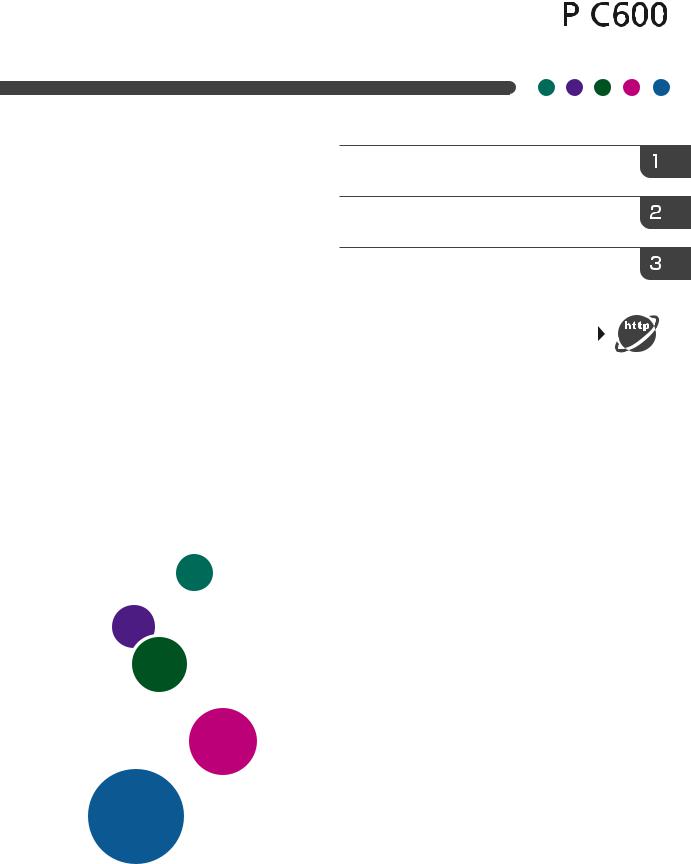
User Guide
Getting Started
Loading Paper
Troubleshooting
For information not found in paper manuals, see the online manuals available on our web site (https://www.ricoh.com/).
For safe and correct use, be sure to read Safety Information before using the machine.
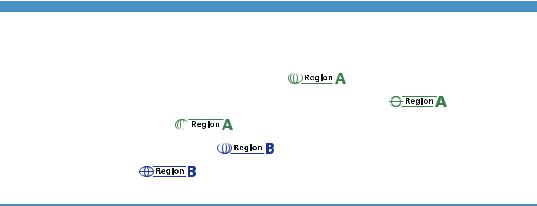
TABLE OF CONTENTS |
|
Manuals for This Machine................................................................................................................................. |
4 |
Information for This Printer.................................................................................................................................. |
6 |
User Information on Electrical & Electronic Equipment ........................................................... |
6 |
Note for the Battery and/or Accumulator Symbol (For EU countries only) .......................... |
6 |
Environmental Advice for Users ................................................................................................ |
7 |
Notes for users in the state of California ................................................................................... |
8 |
ENERGY STAR Program ............................................................................................................ |
8 |
1. Getting Started |
|
Before You Start............................................................................................................................................... |
11 |
How to Read the Manuals.......................................................................................................................... |
11 |
Model-Specific Information........................................................................................................................ |
12 |
List of Options............................................................................................................................................... |
13 |
Guide to Names and Functions of Components............................................................................................ |
15 |
Guide to Components................................................................................................................................. |
15 |
Guide to the Names and Functions of the Control Panel......................................................................... |
19 |
Guide to the Names and Functions of the Control Panel Screen............................................................ |
20 |
Installing Options............................................................................................................................................. |
22 |
Order of Option Installation........................................................................................................................ |
22 |
Attaching the 500-sheet Paper Feed Unit.................................................................................................. |
22 |
Installing the Hard Disk................................................................................................................................ |
24 |
Installing the Interface Units........................................................................................................................ |
28 |
Installing SD Card Options......................................................................................................................... |
33 |
Turning On/Off the Power.............................................................................................................................. |
35 |
Turning On the Power.................................................................................................................................. |
35 |
Turning Off the Power.................................................................................................................................. |
35 |
Saving Energy.............................................................................................................................................. |
36 |
Replenishing and Replacing Consumables.................................................................................................... |
38 |
Replacing the Print Cartridge...................................................................................................................... |
38 |
Replacing the Waste Toner Bottle.............................................................................................................. |
42 |
Displaying the Printer Configuration Screens Using the Control Panel........................................................ |
47 |
Configuring Printer Settings from the [Menu] key...................................................................................... |
47 |
Using Web Image Monitor............................................................................................................................. |
48 |
Displaying the top page.............................................................................................................................. |
49 |
1
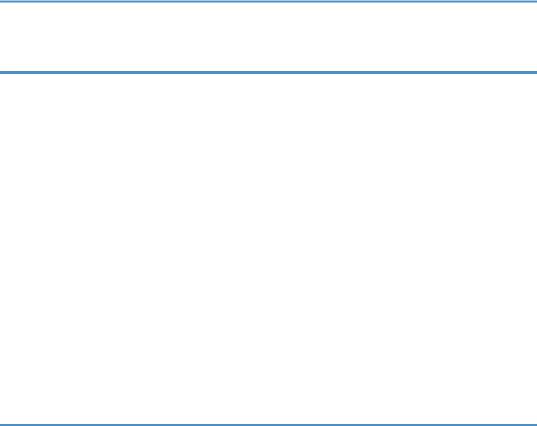
2. Loading Paper |
|
Paper Loading Procedure................................................................................................................................ |
53 |
Paper Size Specifications................................................................................................................................ |
54 |
Paper Type Specifications............................................................................................................................... |
57 |
Paper Precautions............................................................................................................................................. |
59 |
Loading Paper into Paper Trays...................................................................................................................... |
62 |
Loading Paper into the Bypass Tray............................................................................................................... |
65 |
Loading Orientation-Fixed Paper or Two-Sided Paper................................................................................ |
67 |
Loading Envelopes........................................................................................................................................... |
69 |
Printing on Envelopes with Windows (PCL 6/PostScript 3)..................................................................... |
71 |
Printing on Envelopes with OS X/macOS................................................................................................. |
71 |
Paper Settings................................................................................................................................................... |
73 |
Specifying a Paper Size.............................................................................................................................. |
73 |
Specifying a Paper Type............................................................................................................................. |
74 |
Configuring Envelope Settings Using the Control Panel........................................................................... |
74 |
3. Troubleshooting |
|
When a Panel Tone Beeps.............................................................................................................................. |
77 |
When Checking the Indicator Lamps, Status Icons, and Messages on the Control Panel......................... |
78 |
Indicators...................................................................................................................................................... |
78 |
If USB Connection Fails................................................................................................................................... |
79 |
When Messages Are Displayed..................................................................................................................... |
80 |
Status Messages.......................................................................................................................................... |
80 |
Alert Messages (Displayed on the Control Panel).................................................................................... |
81 |
Alert Messages (Printed on Error Logs and Reports)................................................................................ |
87 |
When You Cannot Print................................................................................................................................... |
93 |
Other Printing Problems................................................................................................................................... |
97 |
When You Cannot Print Properly................................................................................................................ |
97 |
Paper Misfeeds Occur Frequently........................................................................................................... |
103 |
Additional Troubleshooting...................................................................................................................... |
106 |
The Printed Image is Different from the Image on the Computer........................................................... |
111 |
When Printer Is Not Functioning Properly............................................................................................... |
113 |
Removing Jammed Paper.............................................................................................................................. |
115 |
Paper Misfeed Message (A) (E)............................................................................................................... |
115 |
2

Paper Misfeed Message (B) (Z)............................................................................................................... |
117 |
Paper Misfeed Message (C) (D).............................................................................................................. |
119 |
Paper Misfeed Message (Y1) (Y2) (Y3)................................................................................................. |
119 |
Trademarks..................................................................................................................................................... |
121 |
INDEX........................................................................................................................................................... |
123 |
3

Manuals for This Machine
The operating instructions of this machine are provided in the following formats:
|
Format |
|
Manuals |
|
|
|
|
Printed manuals |
|
• |
Safety Information |
|
|
• |
Quick Installation Guide |
|
|
|
|
CD-ROM |
|
• Setup Guide |
|
|
|
|
|
Web page |
|
• |
Safety Information |
|
|
• |
User Guide |
|
|
• Operating Instructions (HTML manuals) |
|
|
|
• |
Quick Installation Guide |
|
|
|
|
Safety Information
Before using the machine, be sure to read the section of this manual entitled Safety Information. It also describes each regulation and environmental conformance.
User Guide
Regarding the basic usage of this machine, frequently used functions, troubleshooting when an error message appears, etc., summaries are provided for each user manual.
Operating Instructions (HTML manuals)
Describes the setup for using the machine, how to use functions to print or for maintenance and specifications, troubleshooting, system settings, and security functions.
Manuals are available in English, German, French, Italian, Spanish, Dutch, and Russian.
User Guide and Security Guide are available in the seven languages above and other languages.
For details about how to use the HTML manuals, see "How to Use the Operating Instructions", Read This First.
Quick Installation Guide
Describes procedures for unpacking and setting up the machine, which include loading paper and installing print cartridge and waste toner bottle, etc.
Setup Guide
Describes how to install and configure each driver. This manual is included in the drivers CD.
•Before you configure the extended security and authentication settings, refer to "Before Using This Printer" in the Security Guide.
4

• You can see the following manuals on the Web page.
• DHCP Option 204
5
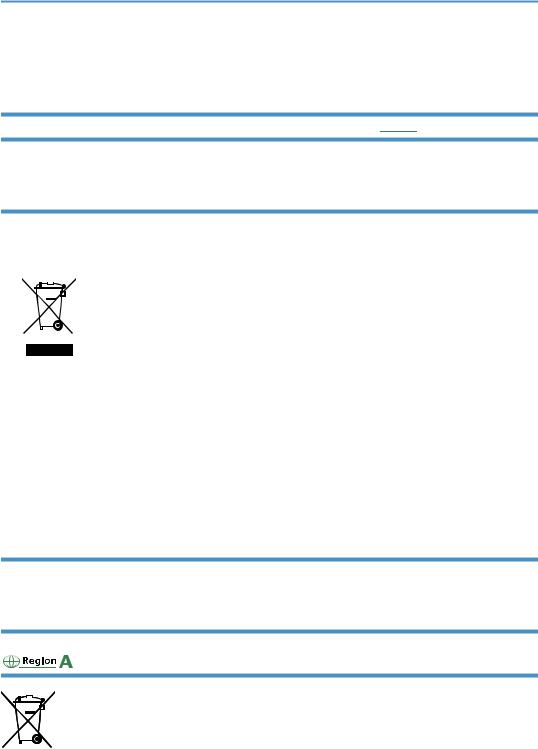
Information for This Printer
User Information on Electrical & Electronic Equipment




Users in the countries where this symbol shown in this section has been specified in national law on collection and treatment of E-waste
Our Products contain high quality components and are designed to facilitate recycling. Our products or product packaging are marked with the symbol below.
The symbol indicates that the product must not be treated as municipal waste. It must be disposed of separately via the appropriate return and collection systems available. By following these instructions you ensure that this product is treated correctly and help to reduce potential impacts on the environment and human health, which could otherwise result from inappropriate handling. Recycling of products helps to conserve natural resources and protect the environment.
For more detailed information on collection and recycling systems for this product, please contact the shop where you purchased it, your local dealer or sales/service representatives.
All Other Users
If you wish to discard this product, please contact your local authorities, the shop where you bought this product, your local dealer or sales/service representatives.
Note for the Battery and/or Accumulator Symbol (For EU countries only)
In accordance with the Battery Directive 2006/66/EC Article 20 Information for end-users Annex II, the above symbol is printed on batteries and accumulators.
6
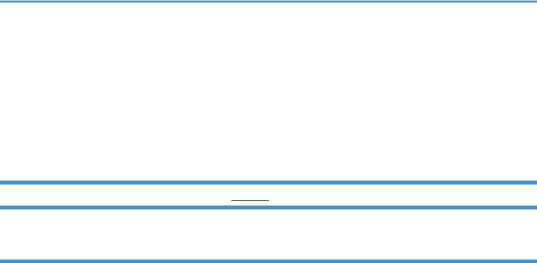
This symbol means that in the European Union, used batteries and accumulators should be disposed of separately from your household waste.
In the EU, there are separate collection systems for not only used electrical and electronic products but also batteries and accumulators.
Please dispose of them correctly at your local community waste collection/recycling centre.
Environmental Advice for Users




Users in the EU, Switzerland and Norway
Consumables yield
Please refer to either the User's Manual for this information or the packaging of the consumable.
Recycled paper
The machine can use recycled paper which is produced in accordance with European standard EN 12281:2002 or DIN 19309. For products using EP printing technology, the machine can print on 64 g/m2 paper, which contains less raw materials and represents a significant resource reduction.
Duplex printing (if applicable)
Duplex printing enables both sides of a sheet of paper to be used. This saves paper and reduces the size of printed documents so that fewer sheets are used. We recommend that this feature is enabled whenever you print.
Toner and ink cartridge return program
Toner and ink cartridge for recycling will be accepted free of charge from users in accordance with local regulations.
For details about the return program, please refer to the Web page below or consult your service person.
https://www.ricoh-return.com/
Energy efficiency
The amount of electricity a machine consumes depends as much on its specifications as it does on the way you use it. The machine is designed to allow you to reduce electricity costs by switching to Ready mode after it prints the last page. If required, it can immediately print again from this mode. If no additional prints are required and a specified period of time passes, the device switches to an energy saving mode.
In these modes, the machine consumes less power (watts). If the machine is to print again, it needs a little longer to return from an energy saving mode than from Ready mode.
For maximum energy savings, we recommend that the default setting for power management is used.
7
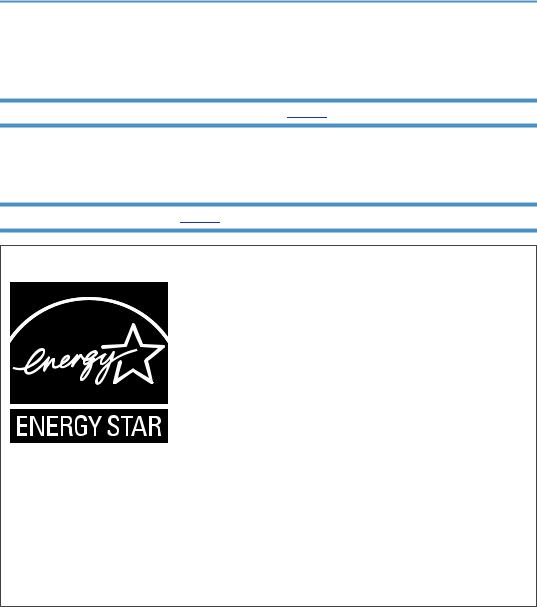
Products that comply with the Energy Star requirement are always energy efficient.
Notes for users in the state of California




Perchlorate Material - special handling may apply. See: www.dtsc.ca.gov/hazardouswaste/ perchlorate
ENERGY STAR Program




ENERGY STAR® Program Requirements for Imaging Equipment
The ENERGY STAR® Program Requirements for Imaging Equipment encourage energy conservation by promoting energy efficient computers and other office equipment.
The program backs the development and dissemination of products that feature energy saving functions.
It is an open program in which manufacturers participate voluntarily.
Targeted products are computers, monitors, printers, facsimiles, copiers, scanners, and multifunction devices. Energy Star standards and logos are internationally uniform.
Sleep mode
If this machine remains idle for a specified period, it enters Sleep mode to reduce its electrical consumption.
The default delay time the machine waits before entering Sleep mode is 1 minute. This default time can be changed.
The machine can print jobs from computers while in Sleep mode.
Specification
Reduced electrical consumption in Sleep |
0.53 W |
mode *1 |
|
8

Time of switch into Sleep mode |
1 minute |
|
|
Time of switch out from Sleep mode *1 |
21 seconds |
Duplex Function *2 |
Standard |
*1 The time it takes to switch out from energy saving functions and electrical consumption may differ depending on the conditions and environment of the machine.
*2 Achieves ENERGY STAR energy savings; product fully qualifies when packaged with (or used with) a duplex tray and the duplex function is enabled as an option.
9

10
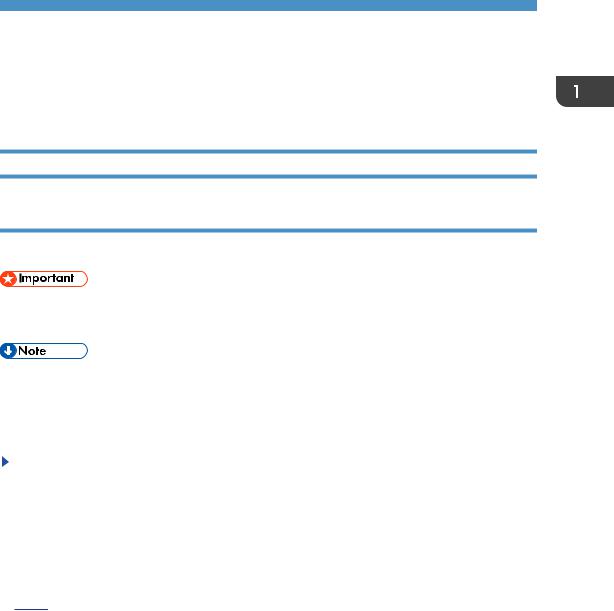
1. Getting Started
This section describes available options, and names and functions of components.
Before You Start
How to Read the Manuals
Symbols used in the manuals
This manual uses the following symbols:
Indicates points to pay attention to when using the machine, and explanations of likely causes of paper misfeeds, damage to originals, or loss of data. Be sure to read these explanations.
Indicates supplementary explanations of the machine's functions, and instructions on resolving user errors.
[ ]
Indicates the names of keys on the machine's display or control panels.
Indicates the key sequence order you should perform using the control panel. Example:
Select [Host Interface]  Press [OK]
Press [OK]
(Select [Host Interface], and then press the [OK] key.)




 (mainly Europe and Asia), (mainly Europe), or (mainly Asia)
(mainly Europe and Asia), (mainly Europe), or (mainly Asia)




 (mainly North America)
(mainly North America)
Differences in the functions of Region A and Region B models are indicated by the two symbols. Read the information indicated by the symbol that corresponds to the region of the model you are using. For details about which symbol corresponds to the model you are using, see page 12 "Model-Specific Information".
11
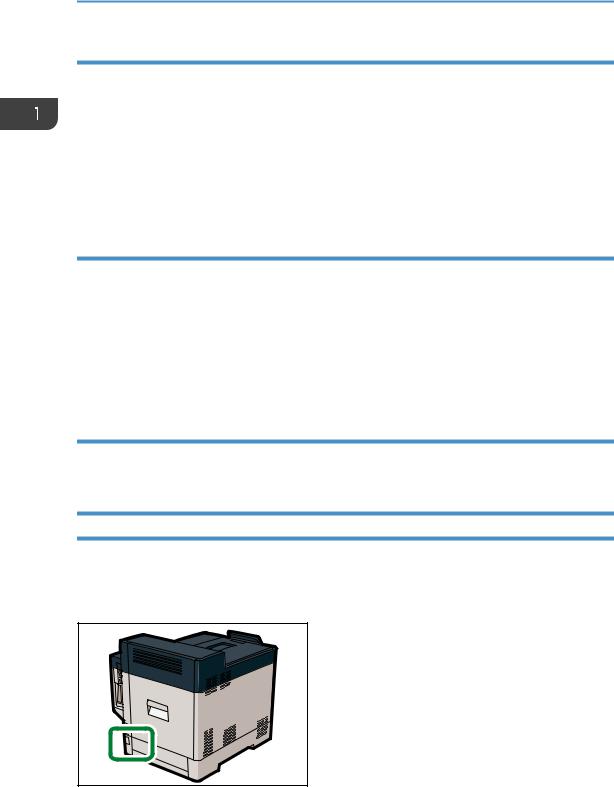
1. Getting Started
Disclaimer
To the maximum extent permitted by applicable laws, in no event will the manufacturer be liable for any damages whatsoever arising out of failures of this machine, losses of the registered data, or the use or non-use of this product and operation manuals provided with it.
Make sure that you always copy or have backups of the data registered in this machine. Documents or data might be erased due to your operational errors or malfunctions of the machine.
In no event will the manufacturer be responsible for any documents created by you using this machine or any results from the data executed by you.
Notes
Contents of this manual are subject to change without prior notice.
The manufacturer shall not be responsible for any damage or expense that might result from the use of parts other than genuine parts from the manufacturer with your office products.
For good output quality, the manufacturer recommends that you use genuine toner from the manufacturer.
Some illustrations in this manual might be slightly different from the machine.
About IP addresses
In this manual, "IP address" covers both IPv4 and IPv6 environments. Read the instructions that are relevant to the environment you are using.
Model-Specific Information
This section explains how to identify the region to which your printer belongs.
There is a label on the rear of the printer, located in the position shown below. The label contains details that identify the region to which your printer belongs. Read the label.
EAG335
12
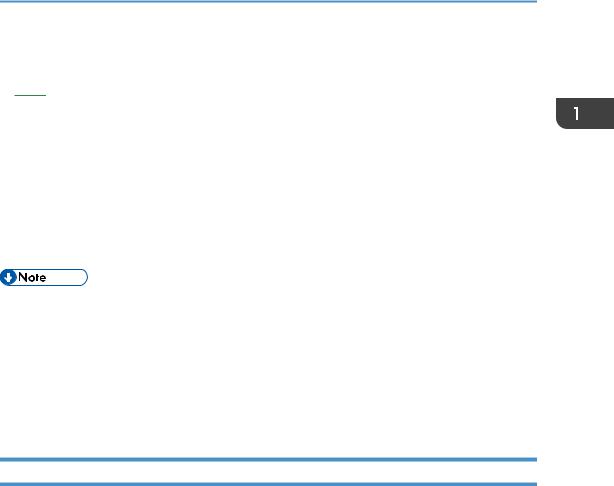
Before You Start
The following information is region-specific. Read the information under the symbol that corresponds to the region of your printer.




 (mainly Europe and Asia)
(mainly Europe and Asia)
If the label contains the following, your printer is a Region A model:
•CODE XXXX -27, -29
•220–240 V




 (mainly North America)
(mainly North America)
If the label contains the following, your printer is a Region B model:
•CODE XXXX -17
•120–127 V
•Dimensions in this manual are given in two measurement units: metric and imperial. If your printer is a Region A model, refer to the metric units. If your printer is a Region B model, refer to the imperial units.
•If your machine is a region A model and "CODE XXXX -27" is printed on the label, see "



 (mainly Europe)" also.
(mainly Europe)" also.
•If your machine is a region A model and "CODE XXXX -29" is printed on the label, see "



 (mainly Asia)" also.
(mainly Asia)" also.
List of Options
This section provides a list of options for this printer and the names commonly used in this manual.
Option name |
Description |
|
|
Paper Feed Unit PB1150 |
500-sheet paper feed unit |
|
|
Hard Disk Drive Option Type P17 |
Hard disk |
|
|
Enhanced Security HDD Option Type M10 |
Enhanced Security HDD |
|
|
IEEE 802.11 Interface Unit Type M24 |
Wireless LAN interface board |
|
|
IEEE 1284 Interface Board Type M19 |
IEEE 1284 interface board |
|
|
USB Device Server Option Type M19A |
USB device server board |
|
|
XPS Direct Print Option Type P17 |
XPS card |
|
|
VM CARD Type P18 |
VM card |
|
|
13

1. Getting Started
Option name |
Description |
|
|
PostScript3 Unit Type P17 |
PostScript 3 Unit |
|
|
Camera Direct Print Card Type P17 |
Camera Direct Print Card |
|
|
14
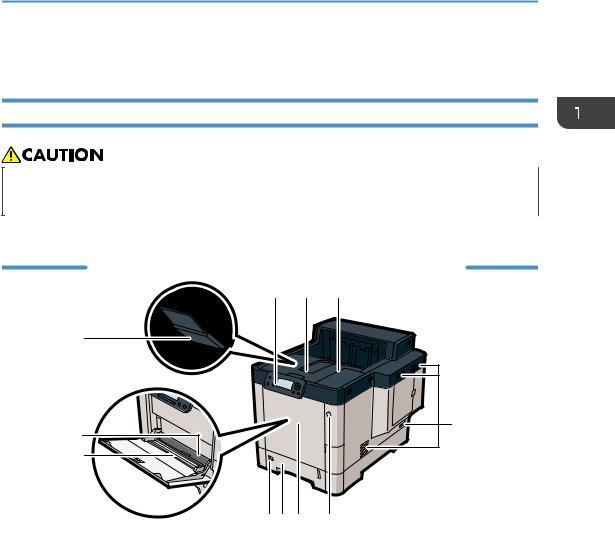
Guide to Names and Functions of Components
Guide to Names and Functions of Components
Guide to Components
•Do not obstruct the machine's vents. Doing so risks fire caused by overheated internal components.
Exterior: Front view
1 2 3
11
10 |
|
|
4 |
|
|
|
|
9 |
|
|
|
8 |
7 |
6 |
5 |
EAG336
1.Control panel
For details, see page 19 "Guide to the Names and Functions of the Control Panel".
2.Top cover
Open to access the inside of the printer and remove jammed paper. Open here to replace the print cartridge.
3.Standard tray
Output is stacked here with the print side down.
4.Vents
Prevent overheating.
5.Main power switch
Use this switch to turn the power on and off.
For details about how to shut down the printer, see page 35 "Turning Off the Power".
15
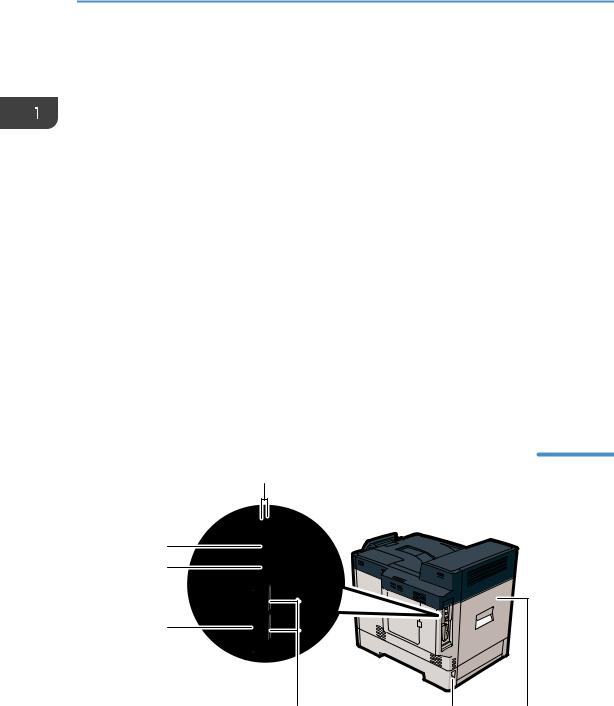
1.Getting Started
6.Front cover
Open to access the inside of the printer and remove jammed paper. Open here to replace the print cartridge.
7.Tray 1
Up to 500 sheets of plain paper can be loaded.
For details about the sizes and types of paper that can be used, see page 54 "Paper Size Specifications" and page 57 "Paper Type Specifications".
8.Paper size dial
Use this dial to specify the paper size. To use a paper size that is not indicated on the paper size dial, set the dial to " ". If this is the case, set the paper size using the control panel.
". If this is the case, set the paper size using the control panel.
9.Bypass tray
Up to 100 sheets of plain paper can be loaded.
For details about the sizes and types of paper that can be used, see page 54 "Paper Size Specifications" and page 57 "Paper Type Specifications".
10.Paper guides
When loading paper in the bypass tray, align the paper guides flush against the paper.
11.Tray Extension
Pull this fence to prevent paper from falling off.
Exterior: Rear view
7
6
5
4
3 |
2 |
1 |
EAG363
1.Rear cover
Open to access the inside of the printer. Open here to replace the fusing unit.
16

Guide to Names and Functions of Components
2.Power connector
Connect the power cord to the printer. Insert the other end into an electrical outlet.
3.SD card slot
Insert the SD card into this slot.
4.Optional interface board slot
Optional interface boards can be inserted. Remove the cover to use this slot.
Insert an optional wireless LAN interface board, IEEE 1284 interface board, USB device server.
5.Ethernet port
Use a network interface cable to connect the printer to a network.
6.USB port B
Use a USB cable to connect the printer to a computer or USB device server.
7.USB port A
Connect external devices such as a card authentication device, etc.
Interior: Front view
1
EAG337
1.Print cartridge
Loads from the printer front, in the order of yellow (Y), cyan (C), magenta (M), and black (K).
Messages appear on the screen when the print cartridge needs to be replaced, or a new cartridge needs to be prepared.
For details about the messages that appear on the screen when consumables need to be replaced, see page 38 "Replenishing and Replacing Consumables".
17
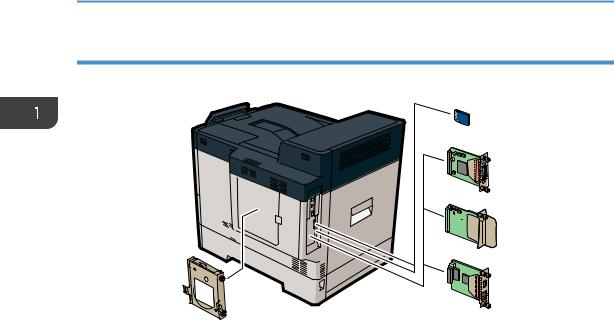
1. Getting Started
Guide to functions of the printer's internal options
1






 2 3
2 3 




EAG338
1.SD memory card options
•Camera direct print card
Allows you to directly print images taken with a PictBridge-compatible digital camera.
•VM card
With this card, you can install embedded software applications.
•XPS card
Allows you to print XPS files.
To attach this option, see page 33 "Installing SD Card Options".
2.Optional interface units
•IEEE 1284 interface board
Allows you to connect to an IEEE 1284 cable.
•Wireless LAN board
Allows you to communicate over a wireless LAN.
•USB device server
Allows you to add an Ethernet port to the printer and use two IP addresses at the same time. To attach this option, see page 28 "Installing the Interface Units".
3.Hard Disk
•Hard disk
Allows you to store documents to be printed.
•Enhanced Security HDD
To install the hard disk, contact your service representative.
Allows you to enhance the security of the hard disk by using an encryption function that is compliant with FIPS 140-2.
18
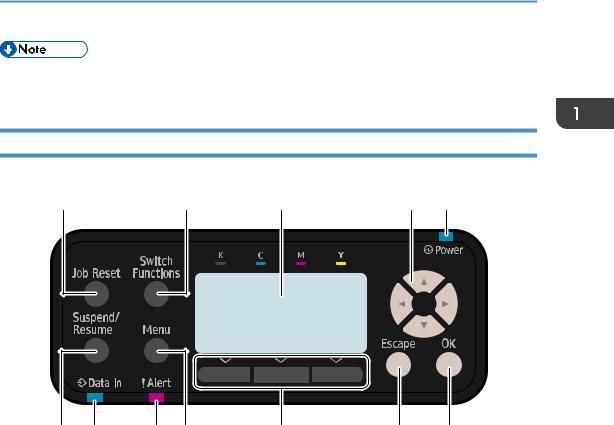
Guide to Names and Functions of Components
•If you want to use two or more SD cards that can be inserted in the same slot, contact your sales or service representative.
Guide to the Names and Functions of the Control Panel
This illustration shows the control panel of the printer.
1 |
2 |
3 |
4 |
5 |
6 |
7 |
8 |
9 |
10 |
11 |
12 |
EAG041 |
|
|
|
|
|
|
|
1.[Job Reset] key
Press to cancel the current print job.
2.[Switch Functions] key
Press this key to switch between the operation screen of the printer function and the function screens of the extended features currently in use.
3.Display
Displays current printer status and error messages.
Entering energy saver mode turns off the back light. For details about energy saver mode, see page 36 "Saving Energy".
4.Scroll keys
Press these keys to move the cursor in each direction.
When the [ ] [
] [ ] [
] [ ] [
] [ ] keys appear in this manual, press the applicable key for the direction that you want to move the cursor.
] keys appear in this manual, press the applicable key for the direction that you want to move the cursor.
5.Power indicator
Lights up when the printer is ready to receive data from a computer. Flashes when the printer is warming up or receiving data. It is unlit when the power is off or when the printer is in energy saver mode.
19
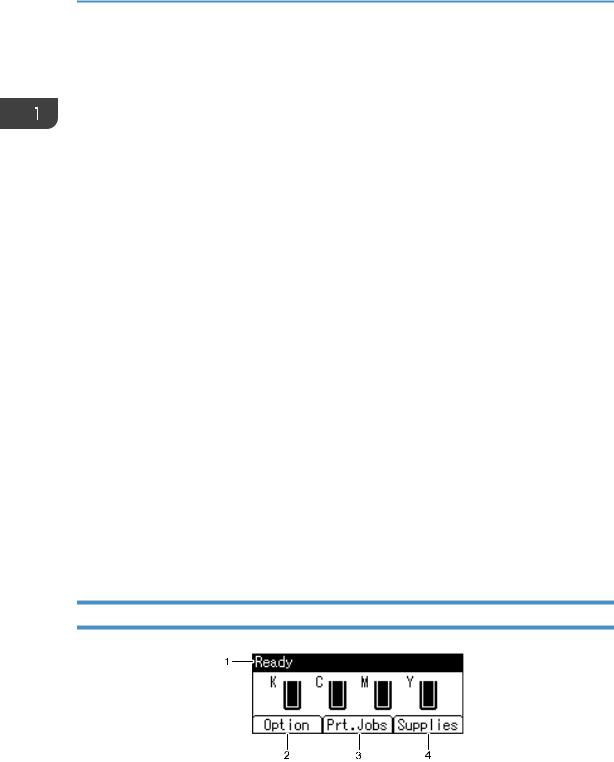
1.Getting Started
6.[Suspend/Resume] key
Press this to suspend the print job currently being processed. The indicator remains lit as long as the job is suspended.
To resume the job, press this key again. The suspended job will resume automatically when the time specified in [Auto Reset Timer] elapses (default: 60 seconds).
For details about the [Auto Reset Timer] setting, see "Timer Settings", Operating Instructions.
7.Data in indicator
Flashes when the printer is receiving data from a computer. The data in indicator is lit if there is data to be printed.
8.Alert indicator
Lights up or flashes when a printer error occurs.
Steady red: printing is not possible, or is possible but print quality cannot be ensured.
Flashing yellow: the printer will soon require maintenance or a replacement consumable such as print cartridge.
Follow the instructions that appear on the display.
9.[Menu] key
Press this key to configure and check the current printer settings.
Press to change the default settings to meet your requirements. See "Function Details of the Printer Configuration Items", Operating Instructions.
10.Selection keys
Correspond to the function items at the bottom line on the display.
Example: When this manual instructs you to press [Option], press the selection key on the left below the initial screen.
11.[Escape] key
Press this key to cancel an operation or return to the previous display.
12.[OK] key
Use this key to confirm settings or setting values, or move to the next menu level.
Guide to the Names and Functions of the Control Panel Screen
CYN901
20

Guide to Names and Functions of Components
1.Operational Status or Messages
Displays the printer status and messages.
2.[Option]
Press to display the following items:
•Form Feed
You can output data that is unprintable due to errors such as a missing line-feed code.
•Error Log
If a document cannot be printed due to errors or other reasons, an error log is created. You can check the error log using the control panel.
3.[Prt.Jobs]
Press to display print jobs sent from a computer.
4.[Supplies]
Press to display the information about printer supplies.
•By default, the remaining amount of toner is displayed. To avoid displaying the remaining amount of toner, set [Display Supply Info] to [Off] in [General Settings] under [Maintenance].
21
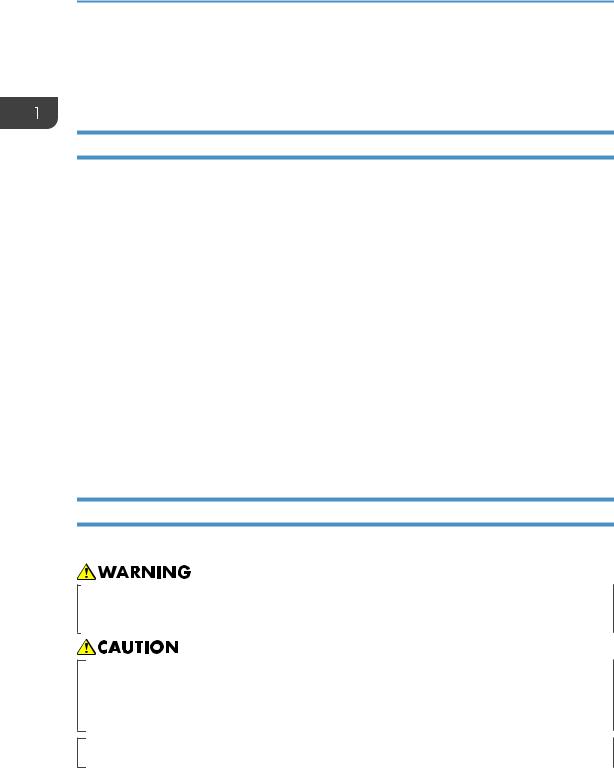
1. Getting Started
Installing Options
By installing options, you can improve printer performance and expand the available features.
Order of Option Installation
When installing multiple options, the following order is recommended:
1.Attach the paper feed unit.
Attach the paper feed unit to the bottom of the printer.
You can attach up to three paper feed units. Up to 2,000 sheets of paper can be loaded in total.
2.Install the hard disk.
3.Install the optional interface board.
Install in the slot of the printer.
4.Insert SD card options.
Insert in the SD card slot of the printer. There are two slots for SD cards.
Each slot supports different types of SD cards.
If you want to use two or more SD cards that can be inserted in the same slot, contact your sales or service representative.
Attaching the 500-sheet Paper Feed Unit
You can install a 500-sheet paper feed units.
•It is dangerous to handle the power cord plug with wet hands. Doing so could result in electric shock.
•The printer weighs approximately 34 kg (75.0 lb.) without toner bottles.
•When moving the machine, use the inset grips on both sides, and lift slowly in pairs. The machine will break or cause injury if dropped.
•Lifting the paper feed unit carelessly or dropping may cause injury.
22

Installing Options
•Unplug the power cord from the wall outlet before you move the machine. While moving the machine, take care that the power cord is not damaged under the machine. Failing to take these
precautions could result in fire or electric shock.
•Do not place the printer directly on the floor.
•When attaching multiple options, attach the paper feed unit first.
•To attach two or three paper feed units at the same time, first stack them one upon the other, and then attach them as a single unit.
•Before turning on the power, remove the packaging material from the paper feed unit.
1.Turn the printer off and unplug the power cord.
2.Remove the packaging from the paper feed unit.
3.Lift the printer using the inset grips on both sides of the printer.
EAG036
Lifting the machine requires two people.
When moving the printer, do not touch the following parts:
•Convex parts on the right side of the machine
•Places indicated on the labels attached to the machine
•The bottom of the optional paper tray
23
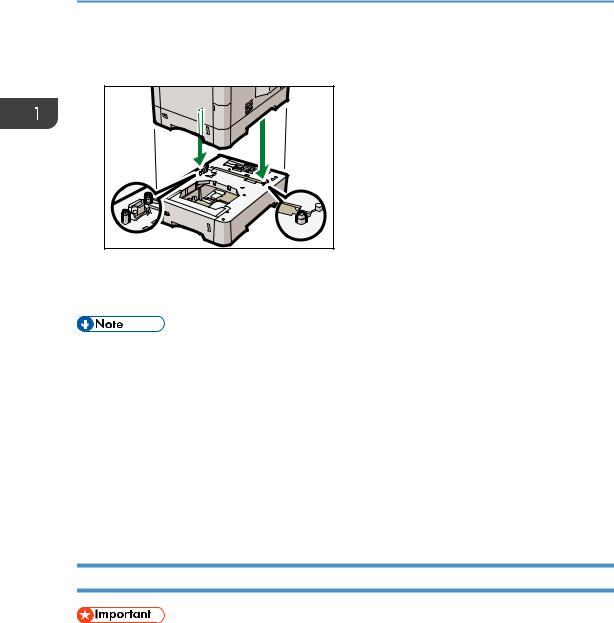
1.Getting Started
4.There are two upright pins on the optional paper feed unit. Align them with the holes on the underside of the printer, and then carefully lower the printer.
EAG037 |
5.Plug in the power cord, and then turn on the printer.
6.Print the configuration page to confirm that the unit was attached correctly.
•To check whether the optional paper feed unit was correctly attached, print the configuration page, and check "Attached Equipment" on the configuration page. If the unit was attached correctly, "Tray 2", "Tray 3" and "Tray 4" will appear.
•For information about printing the configuration page, see "Test Printing", Operating Instructions.
•If the optional paper feed unit was not installed properly, repeat the procedure from the beginning. If it cannot be installed correctly even after trying the installation a second time, contact your sales or service representative.
•To use the paper feed unit, configure the printer options in "Accessories" in the printer driver. For details about opening "Accessories", see "Configuring Option Settings for the Printer", Setup Guide.
Installing the Hard Disk
•Do not touch the inside of the controller board compartment. Doing so may cause a printer malfunction or a burn.
•Before beginning the installation, ground yourself by touching something metal to discharge any static electricity. Static electricity can damage the memory expansion units.
•Do not subject the memory expansion unit to physical shocks.
•Before using the new hard disk, you must configure settings in the printer driver.
•Do not remove the screws on the optional hard disk.
24
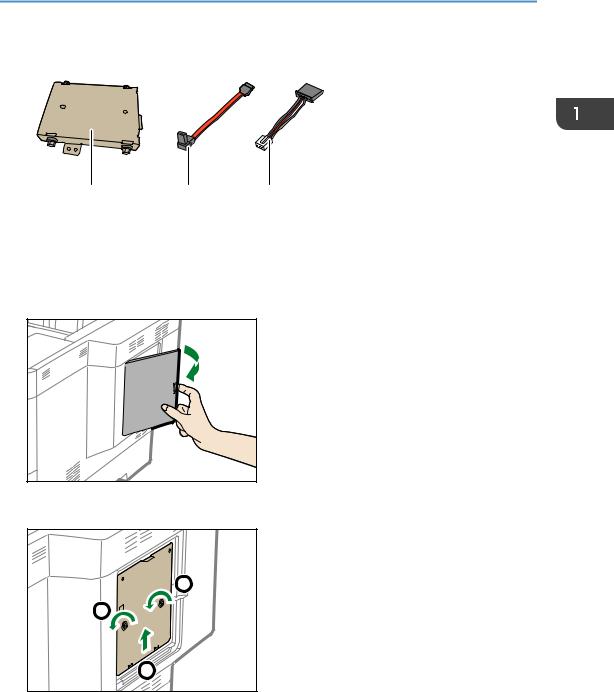
Installing Options
1. Check the contents of the package.
1 |
2 |
3 |
EAG373
1.Hard disk
2.Flat cable
3.Power cord
2.Remove the HDD cover.
HDD cover.
EAG355
3. Loosen the screws by using a coin, and then slide the inner cover to the top to remove it.
 1
1
1
2
EAG356
The figure below shows the location to attach the hard disk drive. It also shows the locations of the receptacles to plug the power cord and the SATA flat cable.
25
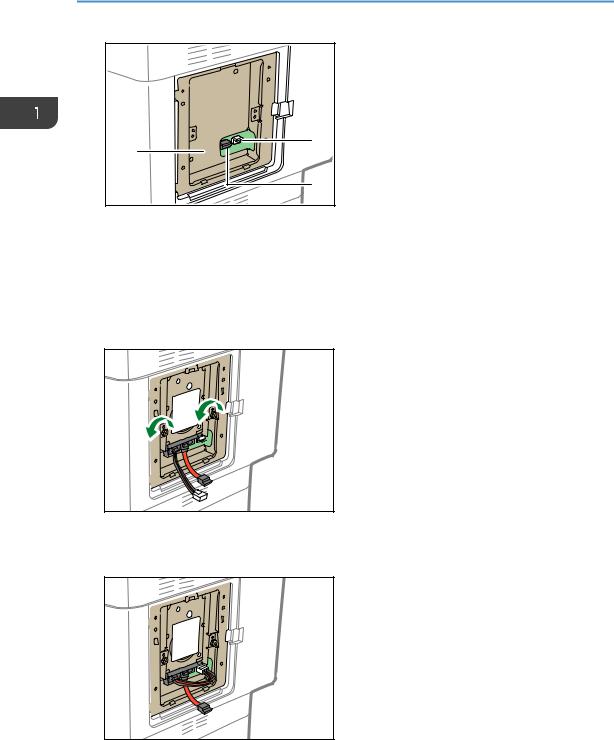
1. Getting Started
1 |
3 |
2 |
EAG357 |
1.Power cord receptacle
2.SATA flat cable receptacle
3.Location to attach the hard disk drive
4.Connect the flat cable and power cord to the hard disk.
5.Lock the hard disk drive on the printer using two screws.
EAG374
6.Plug the power cord into the power cord receptacle with the claw on the cord facing upward.
EAG375
26
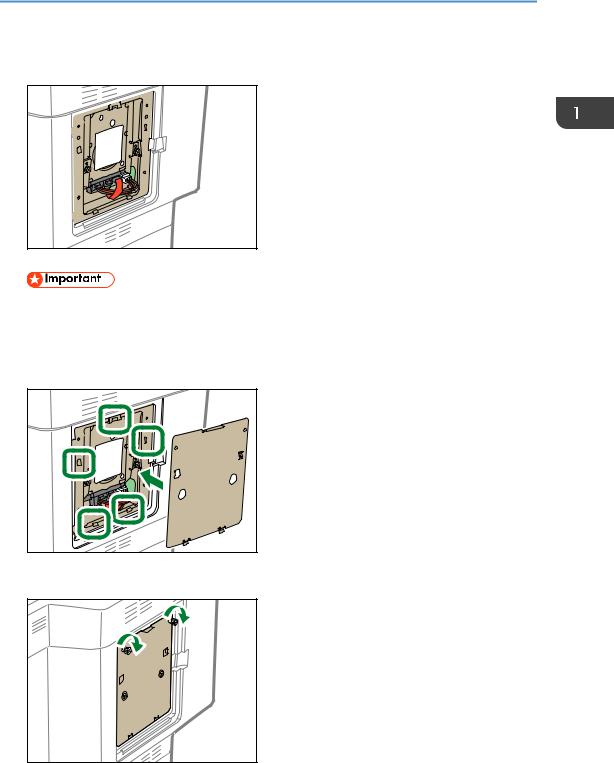
Installing Options
7.Insert the SATA flat cable into the SATA flat cable receptacle with the claw on the cable facing upward.
EAG376
•Connect the SATA flat cable in a way so that the cable goes around the power cord from below.
•Do not twist the SATA flat cable.
8.Insert the five protrusions on the provided inner cover into the notches on the printer.
EAG360 |
9. Tighten the screw.
EAG361
27
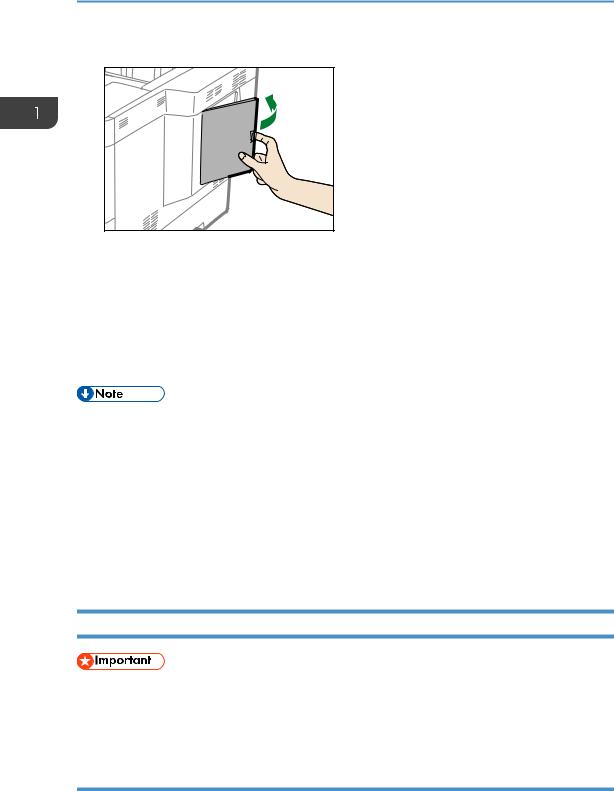
1.Getting Started
10.Attach the HDD cover.
EAG362
11.Plug in the power cord, and then turn on the printer.
When you switch the power on, a message is displayed indicating that the external hard disk drive will be formatted.
Press [OK] to start formatting the drive.
The message is also displayed after replacing the hard disk drive.
12.Print the configuration page to confirm the installation.
•Check that the hard disk was correctly installed by printing the configuration page. If it is correctly installed, "Hard Disk" will appear for "Device Connection" on the configuration page. For details about printing the configuration page, see "Test Printing", Operating Instructions.
•If the hard disk was not installed properly, repeat the procedure from the beginning. If it cannot be installed correctly even after trying the installation a second time, contact your sales or service representative.
•To use the installed hard disk, configure the printer options in "Accessories" in the printer driver. For information about opening "Accessories", see "Configuring Option Settings for the Printer", Setup Guide.
Installing the Interface Units
•Before beginning work, ground yourself by touching something metal to discharge any static electricity. Static electricity can damage the interface units.
•Do not subject the interface units to physical shocks.
Installing the Wireless LAN interface board
1. Check the contents of the package.
28
